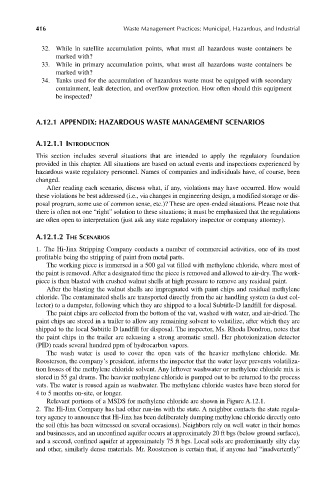Page 445 - Materials Chemistry, Second Edition
P. 445
CAT3525_C12.qxd 1/27/2005 4:11 PM Page 416
416 Waste Management Practices: Municipal, Hazardous, and Industrial
32. While in satellite accumulation points, what must all hazardous waste containers be
marked with?
33. While in primary accumulation points, what must all hazardous waste containers be
marked with?
34. Tanks used for the accumulation of hazardous waste must be equipped with secondary
containment, leak detection, and overflow protection. How often should this equipment
be inspected?
A.12.1 APPENDIX: HAZARDOUS WASTE MANAGEMENT SCENARIOS
A.12.1.1 INTRODUCTION
This section includes several situations that are intended to apply the regulatory foundation
provided in this chapter. All situations are based on actual events and inspections experienced by
hazardous waste regulatory personnel. Names of companies and individuals have, of course, been
changed.
After reading each scenario, discuss what, if any, violations may have occurred. How would
these violations be best addressed (i.e., via changes in engineering design, a modified storage or dis-
posal program, some use of common sense, etc.)? These are open-ended situations. Please note that
there is often not one “right” solution to these situations; it must be emphasized that the regulations
are often open to interpretation (just ask any state regulatory inspector or company attorney).
A.12.1.2 THE SCENARIOS
1. The Hi-Jinx Stripping Company conducts a number of commercial activities, one of its most
profitable being the stripping of paint from metal parts.
The working piece is immersed in a 500 gal vat filled with methylene chloride, where most of
the paint is removed. After a designated time the piece is removed and allowed to air-dry. The work-
piece is then blasted with crushed walnut shells at high pressure to remove any residual paint.
After the blasting the walnut shells are impregnated with paint chips and residual methylene
chloride. The contaminated shells are transported directly from the air handling system (a dust col-
lector) to a dumpster, following which they are shipped to a local Subtitle-D landfill for disposal.
The paint chips are collected from the bottom of the vat, washed with water, and air-dried. The
paint chips are stored in a trailer to allow any remaining solvent to volatilize, after which they are
shipped to the local Subtitle D landfill for disposal. The inspector, Ms. Rhoda Dendron, notes that
the paint chips in the trailer are releasing a strong aromatic smell. Her photoionization detector
(PID) reads several hundred ppm of hydrocarbon vapors.
The wash water is used to cover the open vats of the heavier methylene chloride. Mr.
Roosterson, the company’s president, informs the inspector that the water layer prevents volatiliza-
tion losses of the methylene chloride solvent. Any leftover washwater or methylene chloride mix is
stored in 55 gal drums. The heavier methylene chloride is pumped out to be returned to the process
vats. The water is reused again as washwater. The methylene chloride wastes have been stored for
4 to 5 months on-site, or longer.
Relevant portions of a MSDS for methylene chloride are shown in Figure A.12.1.
2. The Hi-Jinx Company has had other run-ins with the state. A neighbor contacts the state regula-
tory agency to announce that Hi-Jinx has been deliberately dumping methylene chloride directly onto
the soil (this has been witnessed on several occasions). Neighbors rely on well water in their homes
and businesses, and an unconfined aquifer occurs at approximately 20 ft bgs (below ground surface),
and a second, confined aquifer at approximately 75 ft bgs. Local soils are predominantly silty clay
and other, similarly dense materials. Mr. Roosterson is certain that, if anyone had “inadvertently”

